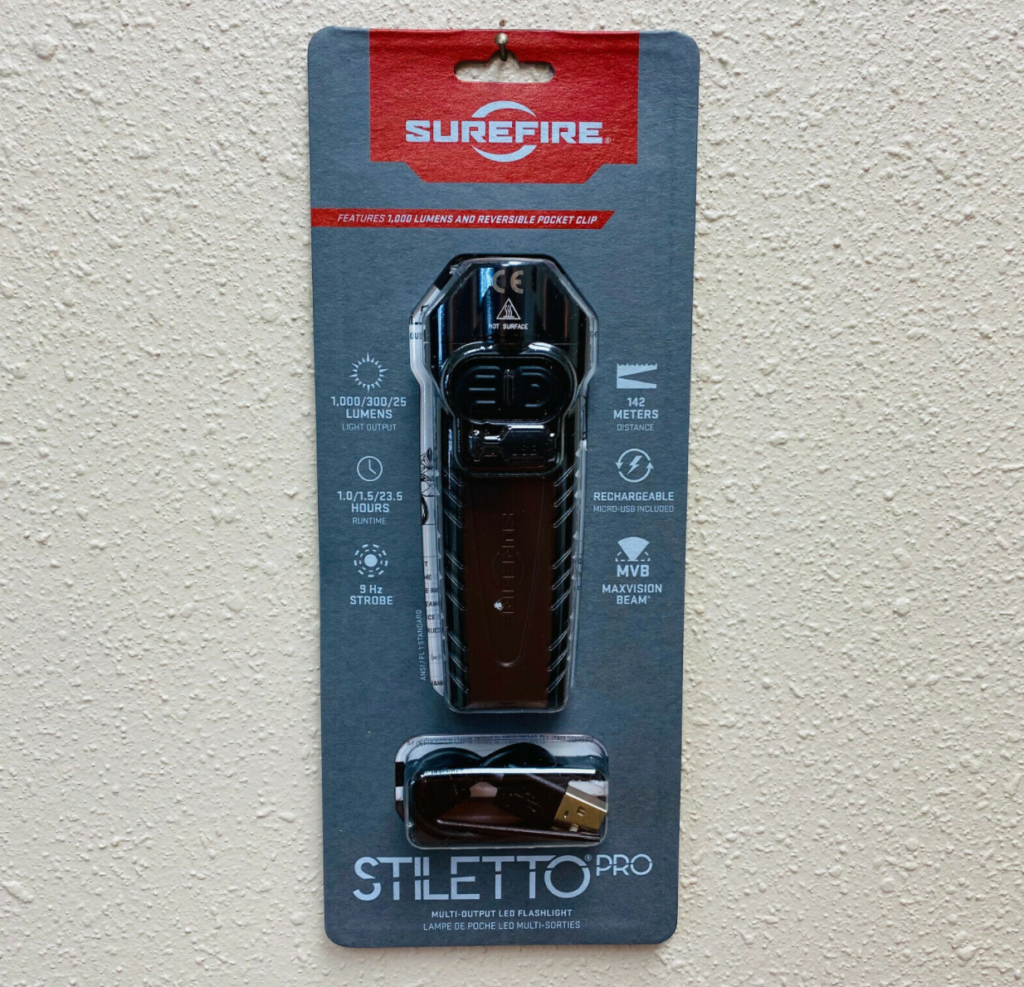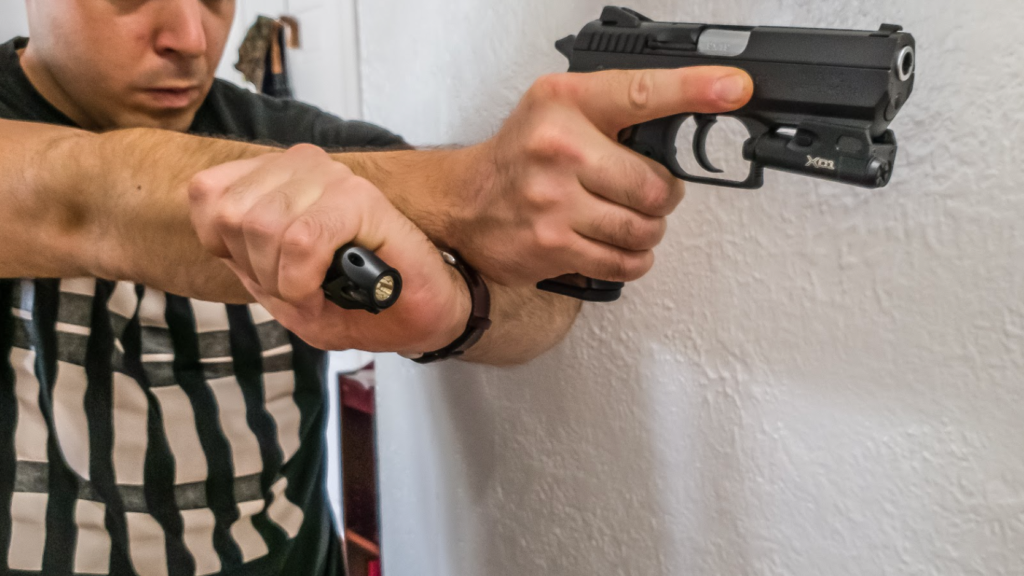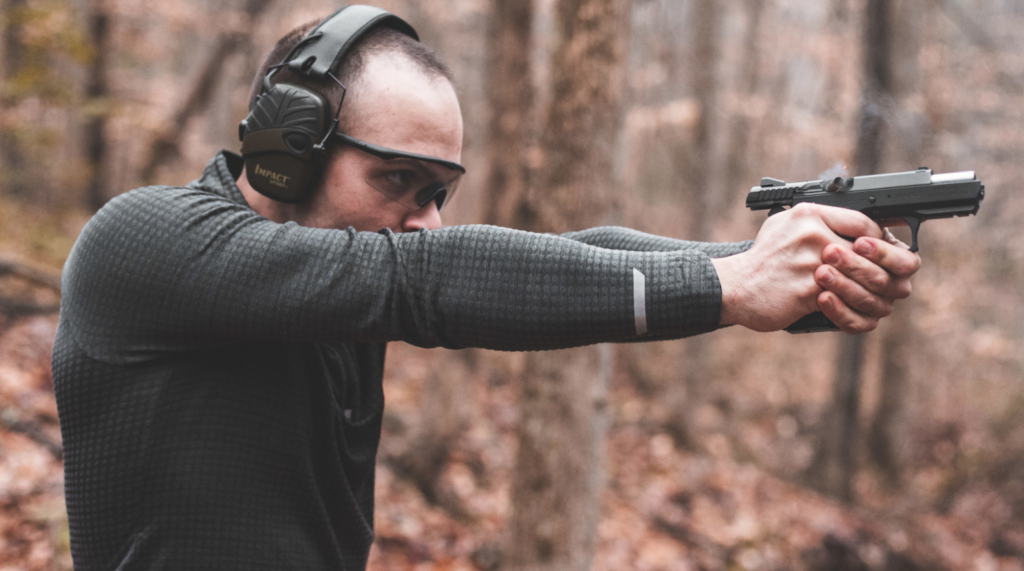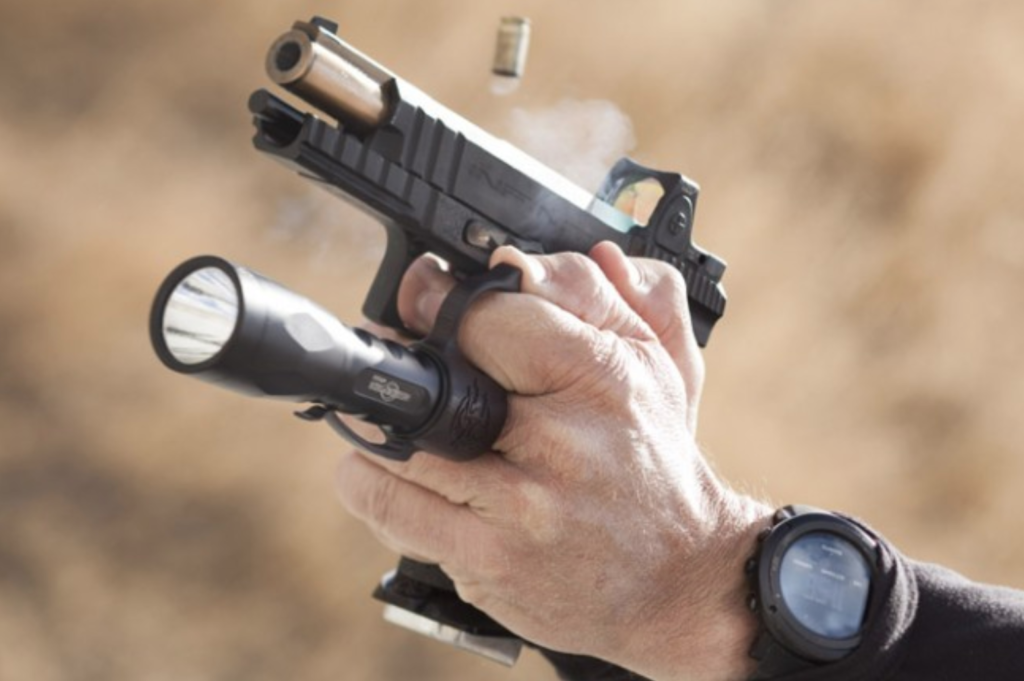SureFire is arguably the tactical flashlight brand in the United States, with their handheld lights, weapon-mounted lights, and helmet lighting systems holding a comfortable position atop the market since at least the 1990s and continuously setting the standard for what it means to be a tactical flashlight. With SureFire the brand to beat when it comes to tactical flashlights, one has to ask why I’m reviewing a handheld light that’s specifically designed to be used for momentary illumination rather than a weapon-mounted light.
The truth is, for a certain size of pistols, or for certain types of pistols, a weapon-mounted light is impractical. I say this as someone who owns probably the most viable compact weapon light on the market, the SureFire XC-1B, which can generate a whopping 200 lumens. Sure, that’s a really bright light, if we’re comparing it to SureFire’s 1990s offerings. But when you couple that with the fact that it’s powered by one AAA battery and the fact that it really seems to have issues mounting to most Picatinny rails, you’re dealing with a system that requires you to cut your losses. And, what’s one to do if they’ve got a smaller handgun that doesn’t feature a rail, such as the Smith and Wesson M&P Shield 2.0, or nearly any compact revolver?
Enter the SureFire Stiletto, named for the needle-thin knives carried as close-quarter last-ditch or finishing weapons since the 15th century which eventually morphed into the switchblades that were the subject of lurid propaganda pieces in magazines such as Woman’s Home Companion in the 1950s. The SureFire invention is obviously not a knife, but a flashlight that’s thin in a different way. This Stiletto seeks to offer the carrier a pocket-friendly light that boasts well over 600 lumens of eye-scorching power for around $100, plus a few other extras. (As a quick disclosure, this light was loaned to me by Task & Purpose for this review, but this does not affect my opinion of the Stiletto in any way, and of course, as always, this article is completely un-sponsored by any brand.)
The Stiletto aims to fill the role of the offhand CCW light — easily carried, powerfully bright, and user-friendly without breaking the bank. Let’s see if that’s actually the case.
The Stiletto comes in my absolute favorite type of packaging, the paper-enclosed plastic clamshell package. The plastic packaging shows off the light as well as the charging cable, stored in a separate bubble below it, and displays the claimed key features of the Stiletto on it, such as the max lumens (650), the maximum range (78 meters), and the battery life (1.75 hours on maximum power.)
On the inverse side, SureFire decided to include this gem of a blurb, which I have to share with you, in all caps: “CHOSEN BY ELITE TACTICAL PROFESSIONALS ON THE BATTLEFIELD AND TRUSTED BY HARDCORE OUTDOORSMEN VOYAGING INTO THE GREAT OUTDOORS, SUREFIRE LIGHTS ARE A PROVEN PERFORMER. TOOLS YOU CAN TRUST TO GET THE JOB DONE AND HELP YOU GET HOME SAFELY. TOOLS DURABLE AND RELIABLE ENOUGH TO HANDLE ANYTHING THROWN YOUR WAY. TOOLS THAT LIVE UP TO THE SUREFIRE NAME, A NAME SYNONYMOUS WITH QUALITY IN THE INDUSTRY THAT WE HELPED CREATE.” And then there’s a smaller bit that says “Backed by SureFire’s no-hassle guarantee.” Right on the box, they’ve said that this is the best option, produced by the best company and that you’ve just spent your money wisely. We’ll see.

The most striking thing about this light is the overall vague coffin shape. It’s 4.5 inches long overall, 1.5 inches wide at maximum, and 1 inch thick including the pocket clip, 0.7 without. It’s a very lightweight unit made of plastic primarily with the exception of the pocket clip and weighs in at just under 3 ounces. On one side are the majority of the controls, a molded SureFire logo, a hot surface warning, and the requisite CE European health and safety marking. The plastic construction is sturdy, in spite of its light construction, and the light is IPX7 rated, which means that you could safely drop it in a meter of water and expect it to work when you fished it out. The opposite side is dominated by a large and very sturdy steel pocket clip that secures the light in a head-up position and is likely fixed in this position to allow you to clip the light onto the brim of a hat or the shoulder strap of body armor for hands-free use. The base of the light also features a two-mode “tactical” switch that, when held down, turns the light onto its highest setting for as long as you hold it, and if you double-tap it, it activates a strobe function to dazzle or disorient an opponent. Finally, the sides of the Stiletto feature very mild serrations for added grip purchase, although how well these work is probably dependent on the size of your hand and how sweaty your palms get under stress.

The controls consist of three buttons, two on the side of the flashlight that features the logo, and the aforementioned tactical switch at the base of the light. These controls are the “primary” switch, which activates the three modes of constant-on light that the Stiletto has, the “programming” switch, which allows you to select the default mode of operation for the activation switches, and the tactical switch, which goes straight from 0 to 650 lumens. The purpose of placing this tactical switch on the base is so that if you’re using it as an offhand tactical light, you’ll use your thumb, rather than any of your other four fingers, which prevents the rare (but greater than zero) chance that you’ll experience the sympathetic reflex motion of, say, both your left and right index finger, where you’d use your left index finger to activate the light and, while under stress, your brain would transmit a sympathetic motor command to your right index finger, i.e. your trigger finger, causing a negligent discharge and possibly killing an innocent person. The placement of the thumb switch also allows you to wrap your other fingers around the Stiletto in such a manner that it fits comfortably into your curled fingers, taking advantage of the flattened shape. Finally, having a dedicated switch that goes straight to the brightest mode of operation means that in crucial, high-stress moments, you have a dedicated switch that does one thing, and one thing only: minimizing the necessity for complicated thought when seconds count.
Programming the light requires a bit more of a learning curve, requiring very specific steps that are, thankfully, clearly outlined in the manual. This programming switch allows you to select which mode the switches engage first. For instance if you wanted the tactical switch to engage the strobe mode first, requiring a double-tap of the switch to be able to hold the light on. Speaking of modes of lighting, the primary switch, by default, goes from a meager five lumens, to 250, all the way to 650, which allows you to pull the light out of the package, and use it with the tactical switch for immediate bright illumination, and the primary switch for more delicate applications, allowing you to gradually increase power for whatever situation is at hand. Featured next to the primary switch is an LED light that indicates programming mode, battery status, and charging progress, showing colors from flashing red to solid green to indicate how full the battery is.
This brings me to the final feature of the layout of the Stiletto: the charging port. The flashlight is powered by a semi-fixed lithium battery that offers 1.75 hours of constant charge at full power, and can be easily refilled using a standard micro USB port, using the included charging cable. However, this cable does not include a wall adapter, which means that you’ll have to use one of your own, or connect it to a larger electronic device. It’s probably a choice to keep packaging size down, but it’s something to consider as my particular Stiletto did not come charged.
The beam cast by the Stiletto is soft, and casts a very wide cone of illumination. This isn’t a light that will give you a very bright core beam with a “halo” effect, which is very common on high-lumen tactical lights. Instead, the entire illuminated area is evenly lit, which is great for a close-quarters environment, producing a 7-foot-wide illuminated area at roughly 7 feet. In addition, the 650 lumens is just bright enough to use in my house with my eyes adjusted to the darkness, as the back-scatter from my white plaster walls didn’t immediately fry my retinas like with some 1,000-lumen plus offerings. In addition, the throw distance of the light is fairly healthy, easily illuminating the street below and allowing me to see detail and color.
How we tested the SureFire Stiletto
My testing primarily focused on the use of the Stiletto as a tactical flashlight to aid the aiming of a handgun in a dark situation. This test consisted of three portions: ease of carry, target acquisition, and the usefulness of the light for non-tactical purposes.
Carrying the Stiletto is very easy, aided by the slim profile. However the head-up carrying configuration is a balancing act between using it as a pocket clip, and clipping the light on the brim of a hat or the shoulder strap of a body armor vest. What I mean by this is that pulling the light out of your pocket and getting it into position to use in an overhand position requires some practice. The method that I’ve found that works for me is to reach only my thumb into my pocket and using my index finger to pinch the Stiletto at the point where the pocket clip bends inward, drawing it from my pocket, closing the rest of my fingers around it, and bringing it up and overhand with my thumb facing me, ready to press the button. It’s not a steep learning curve, but it’s definitely something that the user should consider when training to use this for target illumination.
Carrying this light while wearing body armor is a different set of challenges, considering that the most likely way you’ll be carrying this is in a MOLLE pouch, as many vests and plate carriers can cause clutter that gets in the way of your hip pockets. One issue that challenged me was the fact that while moving, things that brush up against my plate carrier, such as a rifle, would often bump the flashlight and cause it to turn on, which could cause issues for battery life or light discipline, depending on the situation. The solution is the “lockout mode” that the Stiletto features, which is activated by holding down the tactical and primary switches until the LED flashes green, which will prevent the light from being activated until you again press those two buttons, taking it out of lockout mode. While this does solve the issue of accidental activation, it’s a solution to a problem caused by arguable misuse. This really isn’t a light that’s meant for overt situations where you would be wearing armor or webbing of any sort, and the issue with accidental activations was negligible to nonexistent when used as a complement to a concealed handgun in plain clothes. In any case, in more overt situations, weapons would likely have full-sized weapon-mounted lights on them, making the Stiletto a moot point.

The primary purpose of the Stiletto is as a compact tactical flashlight. Drawing my handgun of choice (which for the purposes of this test is an IWI Jericho 941F with a SureFire XC1B and Meprolight tritium night sights), I focused on presenting my pistol one-handed, while trying to make the flashlight draw as simultaneous as the weapon draw, bringing my off forearm under my firing hand to support the considerable heft of the Jericho. The motion was natural and didn’t require much practice, since I’d already established a good technique for drawing the flashlight from my pocket, and this presented a considerable advantage over the XC1B, which, as mentioned above, has a little over half the output power of the Stiletto. I did some control dryfire drills at a target during daylight conditions, which allowed me to use both hands, as well as see the target clearly. Compared to low-light shooting while using my left forearm to support my firing hand, not only does this remove the ability for me to use my left hand to mitigate recoil, but also contributes to slightly more weapon waver, which added roughly a second of target acquisition in between presentation and firing. This wouldn’t be as much of an issue with a smaller weapon, although the recoil mitigation would still be a factor. A plus side to the use of the light is that the illuminated area silhouettes the sight picture, which means that even if you don’t have tritium sights, you will still be able to acquire a target.

A glaring downside that I discovered during this test was the fact that having to actively hold on to the flashlight takes my off-hand out of commission for magazine changes or performing immediate action drills. The design of the Stiletto necessitates that you drop the light to perform any kind of action with the supporting hand. Offhand flashlights designed to be used in conjunction with handguns have existed for decades, but many of them can be fitted with a ring for you to put your index finger through, which allows you to release the flashlight and let it hang while you use the rest of your fingers to correct stoppages or change magazines. These lights are usually much larger though, so it’s going to be up to you to decide what you prioritize when it comes to your concealed-carry setup.

Finally, to make sure that the Stiletto isn’t a unitasker, I tried to use it for normal tasks that I’d ordinarily use a small flashlight for. Using the five-lumen setting was very useful to inspect the inside of my ARs bolt carrier for carbon since that’s easier than doing it by feel with a scraping pick. I also let a friend of mine who’s a motor T mechanic use the light to poke around the engine bays of some 7-ton trucks. He had no complaints about the light, and it lasted him several days on a single charge. The pocket clip also makes the light handy to keep clipped onto the sun visor of my truck, so that I have an emergency light present at all times in the case of a sudden issue on the road at night, and even when I flip the sun visor down, the light will not fall off due to the very sturdy pocket clip.
What we like about the SureFire Stiletto
This is a supremely pocket-friendly flashlight with an excellent lumen count. It’s lightweight, well-designed, and very flexible for the user depending on individual preferences. Additionally, the Stiletto, bearing the SureFire name, comes with a robust warranty and considerable brand prestige. The oblong cross-section of the light makes it very comfortable in the hand as well, which is something that a lot of compact, pocket-sized lights struggle with the fact that it’s rechargeable means that having to buy batteries won’t be an issue for at least several years.
What we don’t like about the SureFire Stiletto
The lack of an option of a finger loop, even a soft one, means that you’ve got no choice but to hope that you never experience a malfunction or burn through one magazine of ammunition. While people like to throw around numbers like “the average defensive shooting features three rounds fired in three seconds from three yards,” using dubiously sourced claims to dismiss things that are not only possible but probable, is ill-advised. Additionally, while I understand the purpose of the pocket clip is set up to allow the light to be clipped onto the brim of a hat or the shoulder strap of body armor, it was a bit of a learning curve from more traditional layouts of tactical flashlights. Maybe a double-sided clip like that of the Streamlight Microstream would work, because while not even nearly in the same league as the Stiletto, the former light solved the issue of mounting flexibility while retaining that more familiar configuration.
Verdict
Ultimately, whether or not the Stiletto fits into your EDC setup is going to be dependent on you, and how you weigh the features against the cost, the form factor against features, etc. This is definitely a light that I would consider incorporating into my setup, since even though I have the XC1B on my Jericho, having a flashlight that I don’t need to present my weapon to use is very handy since, in many jurisdictions, that would be likely considered a crime. If you choose the Stiletto, it will be money well spent, and if you train with the light to overcome the limitations of the system, it will be very effective.
Saved rounds
One of the biggest uses for offhand lights rather than a weapon-mounted light is to overcome both the issues of a.) having a light that you don’t need your weapon to use, and b.) the issue of finding a holster to accommodate both your weapon and your light. If you’re using an uncommon handgun like my Jericho, finding a holster that fits the weapon itself is difficult, let alone one that accommodates a WML. In my case, I had to spend over $100 on a custom holster for my Jericho and the XC1B, and that was only after I found a Kydex shop willing to take on a one-off holster. In retrospect, something like this might have been more advisable, especially given the issues that I discovered with the XC1B.
Another saved round is that they make a SureFire Stiletto Pro, which is the same form factor but made of aluminum, and has a maximum output of 1,000 lumens.
FAQs about the SureFire Stiletto
Q: How much does the SureFire Stiletto cost?
A: $99 on Amazon, MSRP is $129
Q: Is SureFire made in America?
A: Yes, all SureFire products are designed and manufactured in the United States. However, some of their components are imported, such as their LEDs, which aren’t readily available from American manufacturers.
Q: What is the importance of lumens?
A: Lumens are a measure of the total light emitted by a lighting apparatus, and basically translates to how bright a light is. This should not be confused with candela/candlepower, as that’s a measure of light in a particular direction, which doesn’t necessarily correlate to overall performance, since a tighter beam would have greater candlepower, but would not illuminate as much of an area as a lower-candlepower light with the same lumen count.
Q: Why is your hair so whack in the photo of you at the range with the 941?
A: Shit happens, you get older, embrace bald before it embraces you.
Got questions? Comment below & talk with T&P’s editors
We’re here to be expert operators in everything How-To related. Use us, compliment us, tell us we’ve gone full FUBAR. Comment below and let’s talk! You can also shout at us on Twitter or Instagram.
Matt Sampson is an 0861 in the Marine Forces Reserve and a Virginia native. In his past life, he worked in tactical gear retail and is an avid firearms enthusiast. The farthest the Marine Corps has sent him from home is Oklahoma.
Task & Purpose and its partners may earn a commission if you purchase a product through one of our links. Learn more about our product review process.
